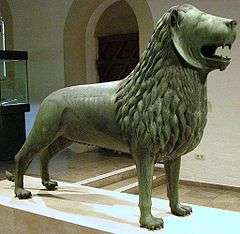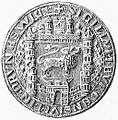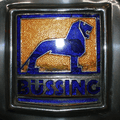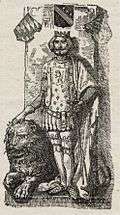Brunswick Lion


.jpg)
The Brunswick Lion (German: Braunschweiger Löwe) is a monument and probably the best-known landmark in the city of Brunswick (German: Braunschweig). It stands on the Burgplatz square in front of Dankwarderode Castle and Brunswick Cathedral. Within Brunswick it is thus commonly known as the "castle lion" (Burglöwe).
The statue
Creation
Henry the Lion (born 1129/30; died 1195), Duke of Bavaria and Saxony, had the lion statue built during his reign in his Residenz at Brunswick around 1166 as a symbol of his ducal authority and jurisdiction.
The Brunswick Lion is the oldest, preserved large sculpture from the Middle Ages north of the Alps and the first large hollow casting of a figure since antiquity. The bronze casting by an unknown artist, probably from Brunswick, weighs 880 kilogrammes, has a height of 1.78 metres, a length of 2.79 metres and a maximum thickness of 12 millimetres.
Replicas
Around the world, but mainly in Germany, there are several replicas of the Brunswick Lion. For example, in front of Ratzeburg Cathedral (erected in 1881), in the interior of Weingarten Abbey, in front of Wiligrad Castle, set up in 1913/14 by John Albert of Mecklenburg (from 1907 to 1913 ruler of the Duchy of Brunswick), disappeared after 1950, in Blankenburg im Harz in 1915 on the terrace of the Great Castle, since 1953 in the Baroque Gardens of the Little Castle and in the Victoria and Albert Museum in London. Other replicas are located here:
Legend
Shortly after the death of Henry the Lion, the ruler became the subject of a folktale, the so-called Heinrichssage.[2] The tale was later also turned into the opera Enrico Leone by Italian composer Agostino Steffani.[3] The Heinrichssage details a fictional account of Henry's pilgrimage to the Holy Land. A popular part of the tale deals with the Brunswick Lion. According to legend, Henry witnessed the fight between a lion and a dragon while on pilgrimage. He joins the lion in its fight and they slay the dragon. The faithful lion then accompanies Henry on his return home. After its master's death, the lion refuses all food and dies of grief on Henry's grave. The people of Brunswick then erect the statue in the lion's honour.[4][5][6]
Gallery
 Brunswick Lion in 1900.
Brunswick Lion in 1900. Brunswick Lion on 1231 seal of the city of Brunswick.
Brunswick Lion on 1231 seal of the city of Brunswick. Brunswick Lion on 5 Reichsmark note.
Brunswick Lion on 5 Reichsmark note. Brunswick Lion on the logo of Büssing.
Brunswick Lion on the logo of Büssing. Henry and his lion (title page illustration from Karl Joseph Simrock's retelling of the folktale (1844)).
Henry and his lion (title page illustration from Karl Joseph Simrock's retelling of the folktale (1844)).
Sources
- Reinhard Bein und Bernhardine Vogel: Nachkriegszeit. Das Braunschweiger Land 1945 bis 1950. Materialien zur Landesgeschichte. Braunschweig 1995
- Braunschweiger Zeitung (Hrsg.): Die 100 größten Braunschweiger, Braunschweig 2005
- Cay Friemuth: Die geraubte Kunst. Der dramatische Wettlauf um die Rettung der Kulturschätze nach dem Zweiten Weltkrieg, Braunschweig 1989
- Martin Gosebruch (Hrsg.): Der Braunschweiger Löwe. Bericht über ein wissenschaftliches Symposion in Braunschweig vom 12.10. bis 15. Oktober 1983. In: Schriftenreihe der Kommission für Niedersächsische Bau- und Kunstgeschichte bei der Braunschweigischen Wissenschaftlichen Gesellschaft. Göttingen 1985
- Mathias Haenchen: Der Sockel des Braunschweiger Löwenmonuments, in: Braunschweigische Heimat - Zeitschrift des Landesvereins für Heimatschutz im Herzogtum Braunschweig, Bd. 84 (1998), S. 8 - 10
- Karl Jordan, Martin Gosebruch: 800 Jahre Braunschweiger Burglöwe 1166 – 1966. Braunschweig 1967
- Jochen Luckhardt und Franz Niehoff (Hrsg.): Heinrich der Löwe und seine Zeit. Herrschaft und Repräsentation der Welfen 1125 – 1235. Katalog der Ausstellung, Braunschweig 1995
- Gerd Spies (Hrsg.): Braunschweig – Das Bild der Stadt in 900 Jahren. Geschichte und Ansichten. Ausstellungskatalog, Braunschweig 1985
- Gerd Spies (Hrsg.): Der Braunschweig Löwe. In: Braunschweiger Werkstücke, Band 62, Braunschweig 1985
- Städtisches Museum Braunschweig (Hrsg.): „Geschichte der Stadt Braunschweig“ im Altstadtrathaus. Ausstellungskatalog, Braunschweig 1991
- Reinhart Staats: Der Braunschweiger Löwe in biblischer Bedeutung. In: Quellen und Beiträge zur Geschichte der Evangelisch-Lutherischen Landeskirche in Braunschweig. Heft 10, Wolfenbüttel 2002
References
- ↑ Gerd Spies (Hrsg.): Braunschweig – Das Bild der Stadt in 900 Jahren. Geschichte und Ansichten, Band 2: Braunschweigs Stadtbild, Braunschweig 1985, p. 17
- ↑ Brothers Grimm. "Heinrich der Löwe" [Henry the Lion - The Brothers' Grimm version]. Deutsche Sagen (in German). Projekt Gutenberg-DE. Retrieved 10 May 2013.
- ↑ Enrico Leone (Heinrich der Löwe)
- ↑ Combellack, C. R. B. (1955), "Die Sage von Heinrich dem Löwen. Ihr Ursprung, Ihre Entwicklung und Ihre Überlieferung by Karl Hoppe", Comparative Literature, 7 (2): 160–162, doi:10.2307/1769130, JSTOR 1769130
- ↑ Jäckel, Dirk (2006), Der Herrscher als Löwe: Ursprung und Gebrauch eines politischen Symbols im Früh- und Hochmittelalter (in German), Cologne / Weimar: Böhlau Verlag, pp. 163–164
- ↑ Pollach, Günter (2011), Kaleidoskop der Mächtigen: Randglossen zu überlieferten Mythen und Episoden der Geschichte (in German), pp. 64–67
External links
| Wikimedia Commons has media related to Braunschweiger Löwe. |
Coordinates: 52°15′53″N 10°31′25″E / 52.26472°N 10.52361°E


